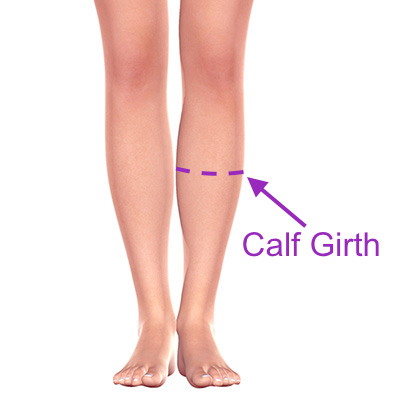Looking to Buy a Pair of properly-sized Compression Socks?
Click the button below to see the lineup of ComproGear Compression Socks.
NOTE: The page includes a sizing chart and free returns, so you’re always sure to get the perfect size!
If you have recently been in for surgery, your doctor may have asked you to wear antiembolic stockings during your recovery.
There are so many great reasons antiembolic stockings are an ideal tool for safeguarding patients‘ health.
These compression garments are easy to use (and unlike medications, they do NOT have a long list of side effects.)
What Are Anti-Embolic Stockings?
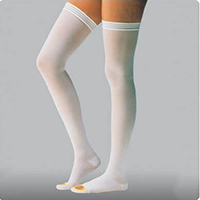
Anti-embolic stockings (also known as TED hose) are made of a stretchy, elastic-like fabric that is meant to gently compress the feet and the legs. They can be purchased as knee-high or thigh-high.
Most surgical patients will be prescribed thigh-high.
These anti-embolism stockings are designed to apply different pressure levels at each part of your leg. The pressure level is highest at the ankle, reducing gradually towards the knee. To deliver the ideal support, the hosiery needs to fit tightly without cutting off circulation.
These garments do lose their effectiveness over time. It is best to replace your anti-embolism compression stockings every three weeks.
Preventing Thromboembolism – Anti-Embolic Leg Compressors have been replaced by Anti-Embolic Garments such as TED Socks and Compression Socks.

“TED” stands for
Thrombo
Embolism
Deterrent
A Thrombo-Embolism is the result of a blood clot (preventing normal flow of blood.)
Blocked blood vessels can cause swelling, pain, or even death (if blood cannot reach the lungs.)
The potential for a blood clot is not to be taken lightly.
Since a thromboembolism can be caused by extended periods of inactivity, TED (Thrombo Embolic Deterrent) and anti-embolism garments are routinely ordered by physicians for all of their postoperative patients.
While you are bedridden throughout recovery, anti-embolism stockings can protect you from blood vessel blockages.
Differences Between TED Hose and Compression Socks
These two types of compression garments can be differentiated by the level of compression they provide and the medical condition they are being worn to prevent.
Compression Socks Are for Standing
Ambulatory people (people who are able to walk) should wear compression socks which have a higher compression rating compared to TED hose.
Remember that:
- Compression socks will have a compression level of at least 15-20mmHg.
- Compression hosiery is meant to support the blood vessels of people who are standing or moving.
Nurses, pregnant women or athletes who struggle with standing and walking for long periods of time will benefit from wearing compression socks.
Looking to Buy a Pair of properly-sized Compression Socks?
Click the button below to see the lineup of ComproGear Compression Socks.
NOTE: The page includes a sizing chart and free returns, so you’re always sure to get the perfect size!
Anti-embolic Stockings Are for In-Bed Recovery
When you are lying down for a long time, blood will pool in your legs. This is what puts you at risk for a blood clot. Inactivity can also cause poor circulation. That’s where anti-embolism hosiery comes in. It provides just enough compression to keep your blood from pooling but not so much pressure so as to cut off circulation. Remember that:
“TEDs are for beds”
- Antiembolism stockings (also known as “TED hose”) are meant to gently support blood flow in people who are lying down and inactive.
- Antiembolism stockings will have a compression level of no more than 8-18 mmHg.
Compression Socks are for Walking Around.
- Compression Socks are for walking around.
- Compression Socks will (usually) have a compression level of 20-30 mmHg (sometimes more).
You may also benefit from anti-embolic medical hosiery if you have fluid retention in your legs. This symptom is common in persons recovering from congestive heart failure.
Anti-Embolic Stockings Guide – How to Choose the Right Pair
An ideal pair of anti-embolic stockings (aka ” TED hose”)will be a quality-made compression garment designed to reduce the risk of deep vein thrombosis. Each stocking should feature a non-constrictive ridge to minimize the risk of tourniquet. Consider these other important aspects as you shop for your TED hose:
Fabric
The best material for antiembolism stockings is twofold microfiber thread (64 filament). This fine microfiber has excellent moisture-wicking action.
Microfiber also gives them a smooth and luxurious feel, reducing the potential for skin irritation. It can also withstand multiple washes.
Toe Inspection Hole
When you are inactive for a long time, blood flow in the toes can become impeded. Hosiery with an inspection hole near the toe allows nursing staff to easily assess toe perfusion (toe pressure) without the need to remove your hose multiple times per day.
Depending on the brand, this opening may be on the bottom or on the top of the stocking foot. Most people prefer the top opening.
Style
You will be able to find both thigh-high and knee-high antiembolism stockings. Neither style is more beneficial than the other, rather, it is a matter of what feels comfortable for you. Look for a non-compressive toe and heel as well, since this style provides additional comfort.
- Thigh-High Socks
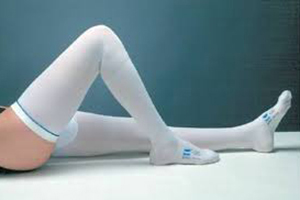
- Knee-High Socks
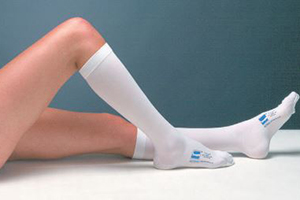
- Thigh-High with Waist Belt
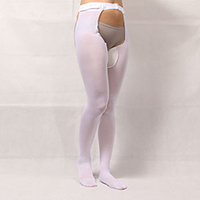
Size
The most important part of choosing a high quality antiembolism stockings is making sure they fit right. If they are not snug enough, you will not receive anti-embolism benefits. If they are too tight, you may suffer from decreased circulation in the legs.
Always look for a brand that comes in a variety of sizes, from extra-small to extra-large for men and women. This allows you to “customize” the fit as much as possible. Some also have color-coding for easy size recognition.
Ideally, the proper fit should feel supportive but not painful. To get the best fit, take measurements of your leg and use those measurements to order your antiembolic hosiery.
Currently Popular on ComproGear
Rose Toy The Rose Toy vs Womanizer Premium
Sizing your Stockings – Why the Right Anti-embolism Stockings Size is Critical
Seriously. Sizing Compression Garment is Key to a successful recovery!
Did we mention sizing?
Looking to Buy a Pair of properly-sized Compression Socks?
Click the button below to see the lineup of ComproGear Compression Socks.
NOTE: The page includes a sizing chart and free returns, so you’re always sure to get the perfect size!
Taking Your Measurement
You can measure your own legs at home or ask for assistance from another person. Always remember to take your measurements as soon as you wake up in the morning. When you first rise, any swelling from the day before will have gone down; this will ensure your measurements are accurate.
Keep the measuring tape in a level position and note down dimensions at each point. The process is simple and involves the following steps:
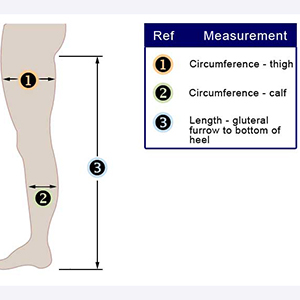
Knee-Length
- Measure the perimeter of your calf at its broadest point.
- Measure your leg length from the bottom of your heel to the back of your knee.
Thigh-Length
- Measure the perimeter of your calf at its broadest point.
- Measure the thigh at its broadest point.
- Then stretch the tape measure from the base of your heel to your gluteal fold on your thigh to measure the length of your leg.
Compare your sizes to the sizing chart of the brand you want to buy from. ComproGear often sells T.E.D. anti-embolism knee-high hose.
An Easy Way to Put on TED Socks
The best way to put on your antiembolism stockings is to first turn them inside out. Now you are ready to begin! Follow this step-by-step infographic to put on your TED hosiery.

- A properly fitted anti-embolism stocking will easily turn itself right side out as you pull it up your leg.
- The application process can be easier if it is done by a relative or friend.
- Ideally, the procedure can be carried out by a nurse in a health care facility.
- Don’t forget to smooth out the material after you have your stocking on.
Contraindications When Using Anti-Embolic Garments
You can easily prevent and reduce complications by following these guidelines:
- It is ill-advisable to use these products on deformed legs. Doing so may worsen your condition. Consult your physician to confirm whether or not your condition would benefit from anti-embolism stocking.
- If you have existing DVT, an arterial disorder, have experienced congestive heart failure, are allergic to dyes or have a skin irritation, do not attempt to use anti-embolism stockings before you consult a medical doctor.
- Avoid the use of this hosiery if you have pulmonary edema or any other form of swelling in your legs. Instead, you should talk to your doctor first.
- Avoid anti-embolic stockings if you have any form of a local leg condition that may be worsened by use of this product.
Conditions That Necessitate a Second Look Before Using Anti-Embolic Stockings
When in doubt, check with your family physician before purchasing your pair of antiembolic stockings. If you have been diagnosed with any of the following illnesses or have gone through a procedure recently, anti-embolism hose may not be for you.
Recent Skin Graft
Skin grafting is a procedure that involves transplanting a healthy thin slice of skin from one section of the body to another section that is injured or damaged.
Panniculitis
This is the infiltration of the subcutaneous tissue by inflammatory cells. Normally, this condition presents itself as swelling of the skin or deep induration.
Fasciitis
Plantar fasciitis is the most common cause of pain on the bottom of the heel. It typically starts upon standing, walking or running. It is most noticeable during the first steps of the morning, typically decreasing in intensity as the body becomes active, only to return after a long resting period.
Gangrene
This condition occurs when tissue dies because its blood supply is interrupted. Gangrene can be caused by an injury, infection or the cumulative effects of a long-term condition that restricts blood circulation. It is most commonly seen in the extremities of the body including the legs, toes, arms and fingers.
Dermatitis
Dermatitis is an inflammatory skin condition, which presents itself with plaques, vesicles, papules, erythematous macules or pruritus.
Cellulitis
This is an infection of the dermal tissues of the limbs. It results in increased blood flow to the leg, presenting with red and inflamed tissues. Cellulitis is often seen on the shin as well as on top of the foot.
Final Thoughts
If you choose to buy and wear antiembolic stockings on your own without the help of a nurse or doctor, you can avoid complications by following these tips:
Do not guess at the ideal size.
Instead, always take the time to do the correct measurements.
Do not pull them up too high.
This could increase pressure over your toes and heels, causing discomfort.
Avoid taking off the hosiery for long periods of time.
Taking long breaks from wearing your compression hose could negatively impact their efficacy. It’s important to keep them on most of the day.
Maintain the hosiery properly.
You can improve the durability of your compression garments by caring for them properly. It is recommended that you remove them once a day to inspect their condition. If you need to clean your anti-embolism hose, hand wash them in cool water and hang them to dry.
Check for skin damage frequently.
If you suspect your skin is damaged, remove the compression hose immediately and inspect your skin for any injuries.
Avoid massaging reddened skin because this can cause more tissue damage.
Reapply the hosiery only when the condition of your skin is healthy. Otherwise, consult your medical doctor for assistance on any injuries to the skin.
Stick with Quality TED Socks
Ensure You Buy a Quality Pair
When it’s your health on the line, quality matters.
Looking to Buy a Pair of properly-sized Compression Socks?
Click the button below to see the lineup of ComproGear Compression Socks.
NOTE: The page includes a sizing chart and free returns, so you’re always sure to get the perfect size!
This page last updated April 15, 2022
